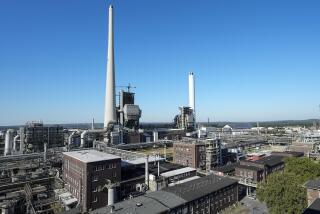A Merry Christmas for German Retailers : Economy: The reunited country has lots of problems to resolve, but for now stores are jammed with holiday shoppers.
- Share via
BERLIN — Although many American merchants are worrying about slow Christmas business, glittering department stores in Germany are jammed with shoppers.
The reunited country is still grappling with unemployment and other economic problems, as it jolts former East Germany out of the communist past into a capitalist future.
But that hasn’t dampened the holiday-buying frenzy in this country of nearly 80 million people.
Germany’s retailers association is predicting sales will match last year’s Christmas shopping binge.
At Berlin’s landmark KaDeWe, the largest department store on the European continent, the harried woman at the information booth directs the arriving throngs like a busy traffic cop at rush hour.
Among the first possible gifts you’ll see: an 8-foot-high “Weihnachtspyramide,” a slowly turning pyramid of Christmas scenes with hand-carved figurines. The price: just 17,995 marks, or $11,400.
“We’re estimating a 10% increase,” said KaDeWe spokeswoman Karin Tauer of this year’s Christmas shopping rush, compared to 1990.
Virtual gridlock has hit many of Berlin’s sidewalks the past few Saturdays, when local shoppers, tourists and eastern Germans flocked to stores.
Even in the outlying Spandau district, customers line up six deep to have gifts wrapped at the Douglas Perfumery, and the cash registers are also busy at the nearby Hertie department store.
Hubertus Tessar, a spokesman for the national retailers’ association, said the German merchants’ mood is “considerably” better than in the United States.
“We’re at a very high level,” he added. “We’re satisfied, but in Germany being satisfied always means things could be better.” German merchants already are bracing for a slowdown in sales next year, the spokesman for the Assn. of German Retailers added.
Tessar said Christmas gift-buying nationwide in Germany this year will be about 28.5 billion marks, or $18 billion, up from last year’s $16.9 billion. But he said that once price hikes are taken into account, the two years will be about the same.
The spokesman said 1990 was a boom year, even though comparisons with 1989 are difficult because East Germany was operating with a communist system then. But Tessar noted that Christmas sales in western Germany climbed to the equivalent of $16 billion at today’s rates last year, up $1.1 billion from 1989.
This year’s results reflect the overall economic situation, in which western Germany’s booming 4.5% growth in 1990 has slowed to an estimated 3% this year.
Last year, many eastern Germans, with their fists full of recently acquired German marks, headed into western Berlin to do their Christmas shopping.
This holiday season, many of those shoppers are staying home, now that western chains have opened up branch stores in eastern Germany.
That, in turn, is crowding streets and sidewalks from the Alexanderplatz in eastern Berlin to major eastern cities such as Dresden, Leipzig and Halle.
More to Read
Sign up for Essential California
The most important California stories and recommendations in your inbox every morning.
You may occasionally receive promotional content from the Los Angeles Times.










